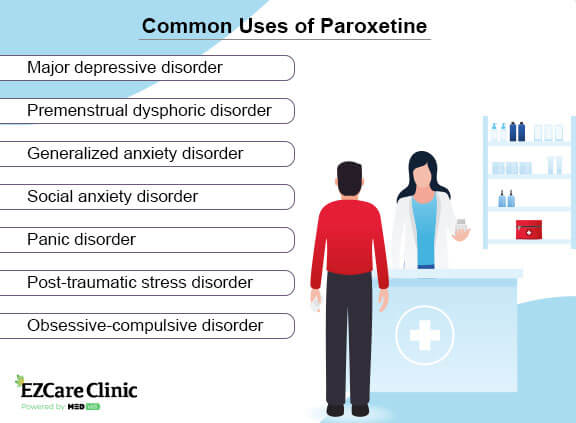Paxil is a medication used to treat depression and anxiety. It belongs to a class of drugs called selective serotonin reuptake inhibitors (SSRIs). It’s also known as paroxetine, which is the generic name for the drug. Paxil is one of the most commonly used drugs for depression and anxiety.
Discuss your symptoms with a mental health professional to get a diagnosis and proper treatment.
Paxil Uses
Paroxetine’s uses cover a range of mental health issues, pointing to the drug’s usefulness and safety and why doctors prefer it. Some of the significant conditions for which it is used include:
- Major depressive disorder. Paxil is used to treat the symptoms of major depression, such as sadness, loss of interest in activities, and changes in appetite and sleep.
- Panic disorder, a condition characterized by sudden and unexpected panic attacks.
Social anxiety disorder, a condition characterized by intense fear and avoidance of social situations. - Obsessive-compulsive disorder (OCD), which involves persistent, unwanted thoughts (obsessions) and repetitive behaviors (compulsions).
- Post-traumatic stress disorder (PTSD), a condition that develops after a traumatic event and is characterized by symptoms such as flashbacks, avoidance behaviors, and increased anxiety.
- Generalized anxiety disorder (GAD), a condition characterized by excessive, unrealistic worry and tension.
- Premenstrual dysphoric disorder (PMDD), a severe form of premenstrual syndrome (PMS) characterized by intense emotional and physical symptoms a week or two before the menstrual period.
Paxil Half-life Explained
How long a drug stays in a patient’s system depends on the drug’s half-life. It is the estimated time it takes for half of the drug’s dose to be used and eliminated from the body. In the case of Paxil medication, the half-life is 21-24 hours. It means it takes about
If a person takes 20 mg of paroxetine medication, only 10 mg will be left in the body 21 hours after stopping the drug. For another 21 days, only 5 mg will be in the body, and for another 21 hours, only 2.5 mg. As such, it can take several days, usually five days to a week, for the drug to be completely eliminated from the body.
Paroxetine’s half-life is one of the shortest among SSRIs. However, there is still a risk of withdrawal symptoms should you stop using the medication suddenly. You should follow your doctor’s guidance on how to wean off the drug to prevent the withdrawal effects of Paxil.
Learn more about the available treatment options for your condition by consulting a mental health expert.

Factors Influencing Paxil’s Effects
Although there is a standard period of 21-24 hours, the time that Paxil stays in the system can vary slightly depending on several factors. Here is what can affect how long Paxil stays in your system:
- Metabolism. Everyone’s metabolism is different, meaning some people may metabolize Paxil more quickly than others, leading to a shorter half-life.
- Dosage. The higher the dosage of Paxil, the longer it will take for the body to metabolize and eliminate the medication.
- Duration of taking the medication. The longer an individual takes Paxil, the longer it may take for the drug to be eliminated from the body.
- Age. As people age, their metabolism may slow, leading to a longer half-life for Paxil.
- Liver function. The liver is responsible for metabolizing Paxil, so if an individual has liver problems, it may take longer for the medication to be eliminated from the body.
- Renal function. Paxil is also excreted through the kidneys, so if an individual has renal problems, it may take longer for the medication to be eliminated from the body.
- Drug interactions. Paxil may interact with other medications an individual takes, affecting how quickly the medication is metabolized and eliminated from the body.
Release Format of Paxil
Paxil (paroxetine) is available in both controlled-release (CR) and standard-release (SR) forms. The controlled-release form is designed to release the medication gradually over time, while the standard-release form releases the drug all at once. This can affect the half-life of the medication, as well as the duration of its effects.
The half-life of Paxil CR is longer than that of Paxil SR. This is because the controlled-release form of the medication is designed to be released gradually over time, which means that it takes longer for the body to metabolize and eliminate the drug.

Conclusion
Paxil is a medication used to treat a variety of mental health conditions, such as major depressive disorder, panic disorder, social anxiety disorder, and obsessive-compulsive disorder. The length of time that Paxil stays in the system can vary depending on factors such as the individual’s metabolism, dosage, and length of time taking the medication.
It can take several days to a week for the drug to be completely eliminated from the body. Consult a healthcare professional or pharmacist for personalized information regarding the appropriate dosage, how long the medication will stay in your body, potential side effects of Paxil, and its interactions with other medications.















